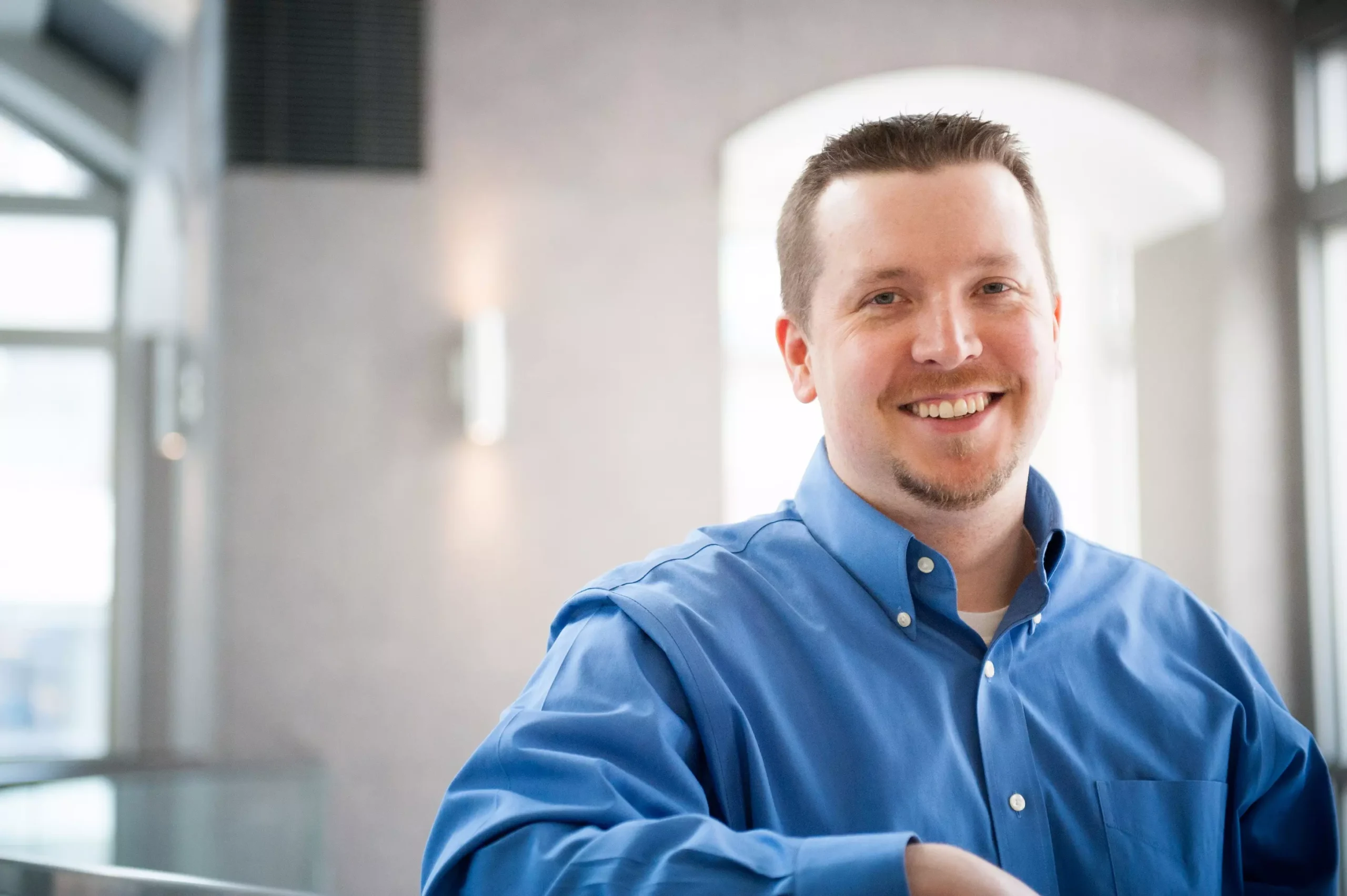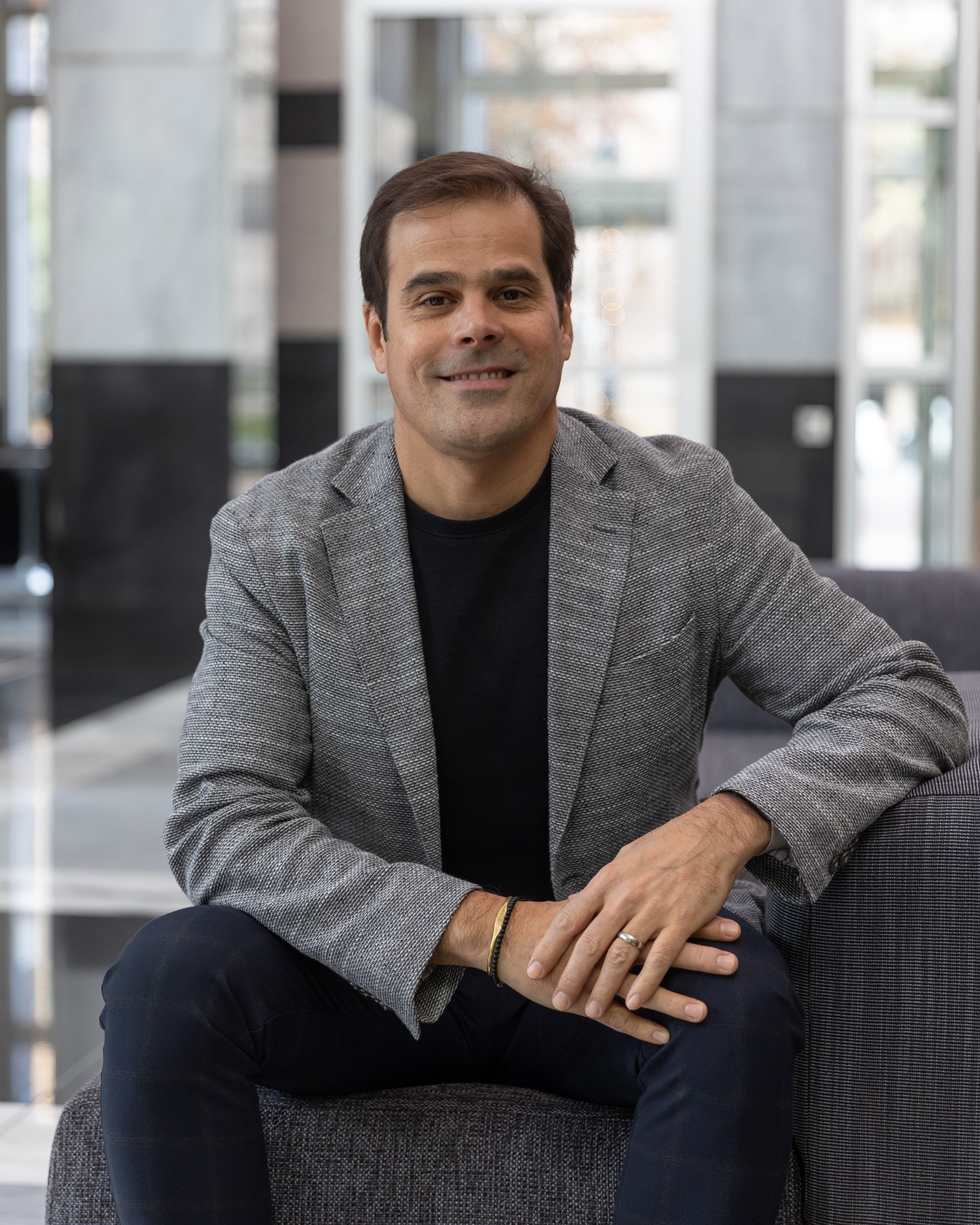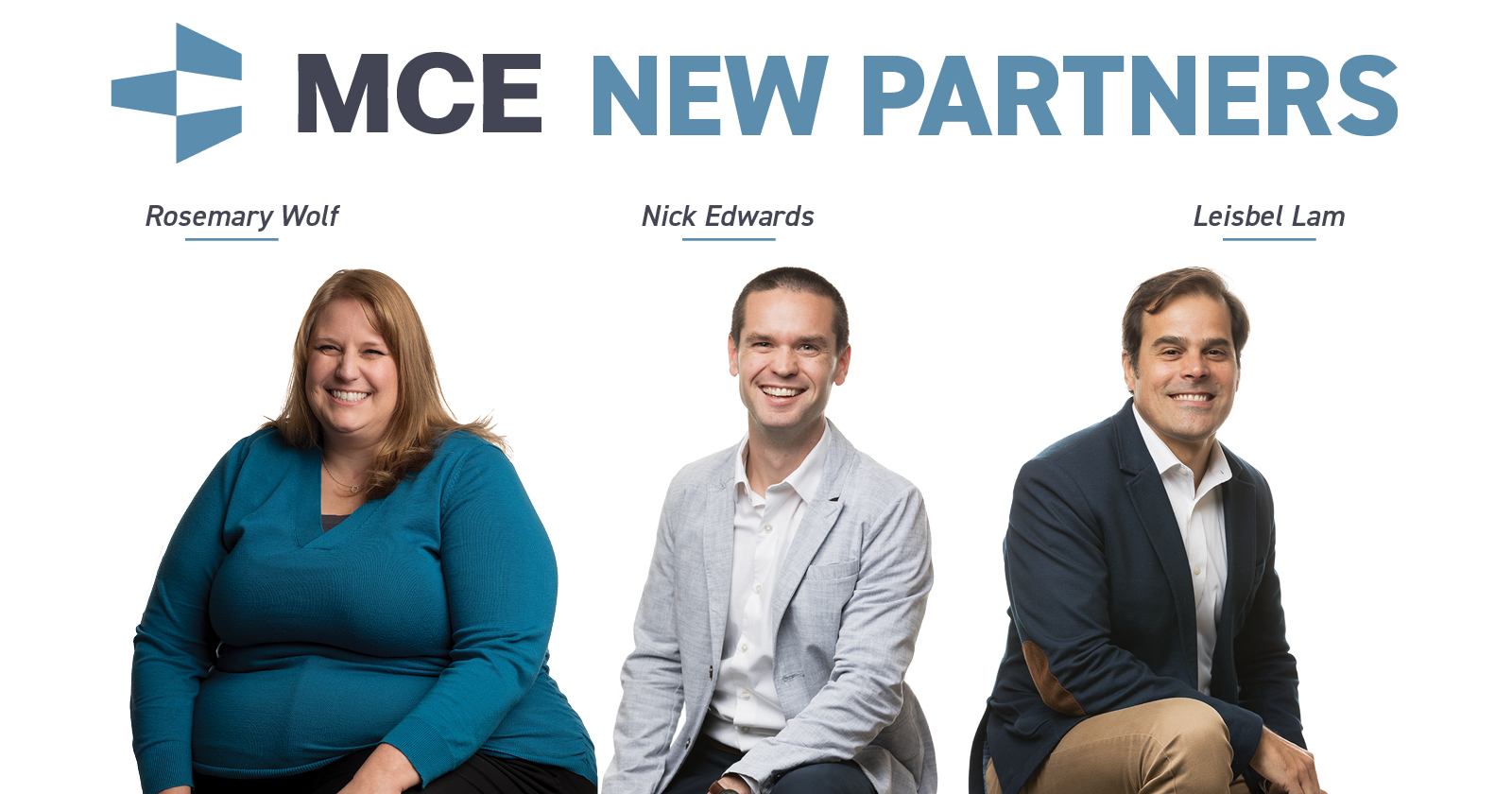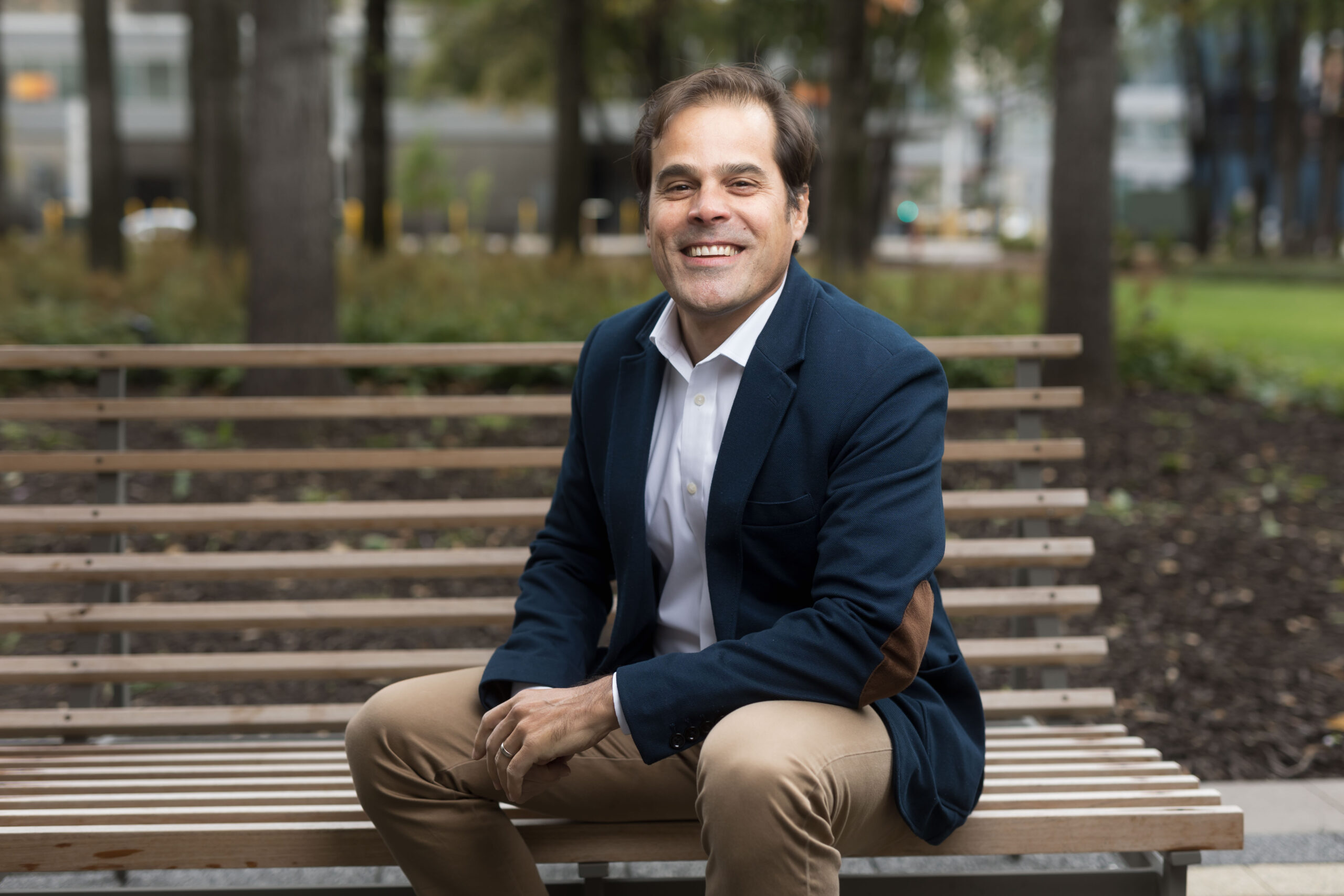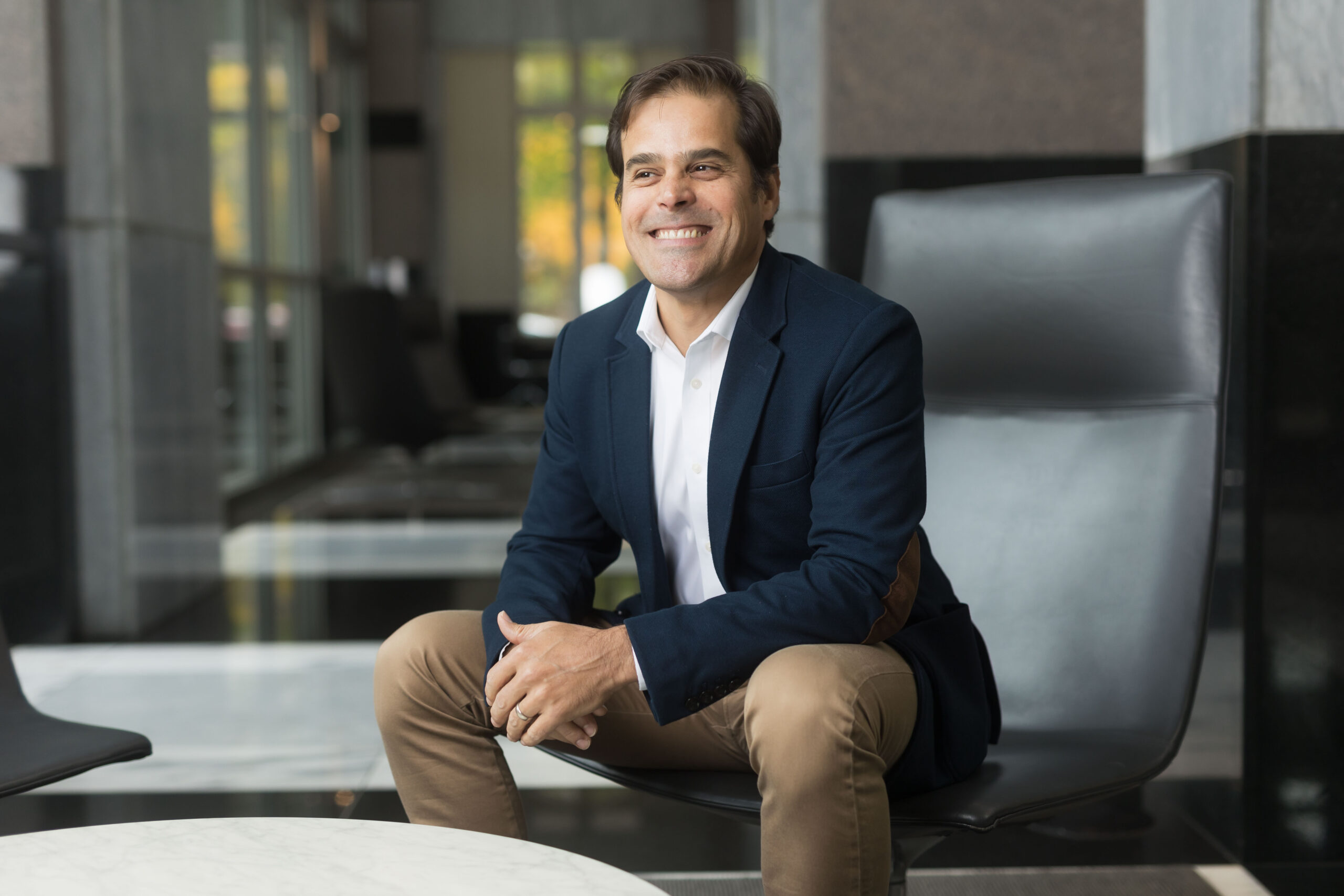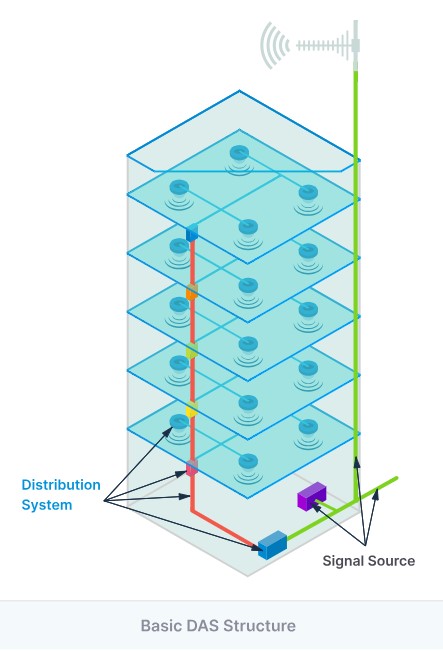*Jeff Clark is no longer with MCE. Please direct any questions you have to our Contact Us page.
In a podcast with Carrie Goetz, Jeff Clark talks about his path starting as a draftsman, to becoming a Principal at the firm. They discuss the importance of CAD and how 3D is changing the industry. Trades and 2 year degrees are a valuable part of this industry. Jeff started via a two-year degree and through diligence earned his degree and a spot as a company owner. They discuss his projects, passion, and journey.
Transcript:
Carrie: Good morning, everybody! This is Carrie Goetz with StrategITcom, and we are back with another episode of our podcast series on careers in the data center and tech industry for women, trades and vets – and today we are talking with Jeff Clark, with Michaud Cooley Erickson, about his path into the industry, which is a bit different than the typical…“go-get-a-degree, jump-into-this-industry.” So Jeff, with that, I’ll let you introduce yourself and a little bit about your company, and then we’ll talk about your journey.
Jeff: Sounds great. Thanks, Carrie! Yes, again, my name is Jeff Clark. I am a – by title, a principal shareholder (which means I own part of the company) of a company called Michaud Cooley Erickson. We are a consulting engineering firm, so we design and manage construction of everything from data centers, to laboratories, to commercial buildings, to just about anything. So, thank you for the introduction.
Carrie: Absolutely! And – so, tell everybody where you’re located.
Jeff: So, we’re located in Minneapolis, Minnesota, home of the Bold North.
Carrie: (laughs) Home of the very cold winters. No thank you!
Jeff: (laughs) The opposite of your territory, so…
Carrie: Exactly. So, tell us a little bit about, kind of, how you got into this industry and how you ended up owning a piece of this company. You know, what was your journey like, and how did you start out, and, you know – did you really even think about being in this industry to start with?
Jeff: Yeah, really good question. So, I guess you could say, my industry journey really started as – in my childhood. I was, actually, to a detriment, I drew a lot. I drew a lot of pictures of buildings, and army tanks, and air force jets and stuff, when I should have been studying, to the point that I actually got, several, one-on-one parent-teacher conferences to talk about this distraction.
Carrie: Uh-oh. (laughs)
Jeff: I was also notorious for taking things apart, to see how they work, but not able to put them back together. So, my parents could tell you we replaced a lot of things growing up because of this passion, but, that’s kind of really where it started and, you could kind of fast forward, now, into when I was in high school. I was pretty into a lot of the hands-on coursework. So, things like metal shop, woodworking, even in the automotive group, like, how to fix a car, you know. Just how stuff worked mechanically always fascinated me. So, I’m sitting there and it’s career day. So, they have a bunch of the different colleges and the Army and the Navy and the Air Force and the Marines were all at the school in the gym…and they had tables for each one of them, and I’m looking around the room…and I’m not one for lines. So, I see there’s this booth of this outfit. They’re called Dunwoody Institute. So, they’re a local, very well-known local, technical school. So, they focus on two-year degrees, and, I see no line. And I walk over there, and I start, strike up a conversation. I said “This is interesting; I’ve heard of you guys. I had family members go here, very reputable place, like…tell me what you’ve got.” And, we kind of go through it and I said “Well, I want something I can draw, and one that makes lots of money.” And they said, “We’ve got the perfect course for you!” And it was a course called “Mechanical Design.” So, really what it was is it was a course focused on design of HVAC – so heating, ventilation, air conditioning, plumbing, and basically systems that make a building livable. I said, “Sign me up. I get to draw,” and…
Carrie: (laughs)
Jeff: …it was, at that time, the entire industry was converting over from, back in the days – everybody’s seen a blueprint, they’re very, well-known in movies – we don’t really use them anymore; it’s a dead technology. But, those were all created with hand-drawn drawings. So, pencil, in some cases ink, you’d literally draw like they do in the movies, you’d erase when you screwed up. Well, the industry was converting over to Computer-Aided Design, also known as CAD. And that’s where I tie in my piece about loving to draw stuff as a kid. I got into CAD in high school. And it was really kind of what drew me, that’s, really was my path into this industry is I, I loved Computer-Aided Design. And I thought “Wow – this is a course…it only takes me two years to get through, and I can get a good job right after.”
So, I said, “Sign me up!” So, there I went. So, I did that, I took the course and did that for two years, and actually had a job, part-time job, basically the second half of the first year. So, I was actually working for an engineering firm, obviously an entry-level position doing basic drafting tasks and CAD and such, and did that, all the way through graduation, and then immediately basically the day after I graduated, I was given a full-time position with the firm I was first, first working for.
Carrie: …I’m gonna–, I think that’s, that’s really important to talk about, you know, in this country, I think we’ve done kind of a bad job of supporting people in two-year degrees, in trades, and realize, you know–, if it weren’t for trades and, and a LOT of those people with two-year degrees, nothing would get built. So…
Jeff: Yeah, exactly.
Carrie: …there’s certainly, you know, lots of paths into the industry. So, what–, you know, when you started your job kind of, what got you from there to owning the joint?
Jeff: Yeah, good question. So, kind of, when you start off, and it’s even true today, you–, you really have to learn the tools. And in an engineering firm, the lifeblood of the company, that actually makes the drawings, is the CAD system. So, you’ve really got to learn CAD. Now, the course I went to, at least at that time, gave you a basic overview as part of the curriculum. Fast-forward to now: they spend a lot more time in that two-year program actually teaching you the CAD system, and really there’s…CAD is a very generalistic term, and it’s a general program, so the most common CAD program people use is called AutoCAD, and that–, AutoCAD is used by all sorts of industries, not just ours, so, meaning, out of the box, it’s very vanilla, and, for each industry that utilizes it, it’s usually heavily customized. So, one of the issues you deal with, with folks that maybe went to a four-year institution or went to a-, a kind of a…more traditional engineering school, is they don’t really teach you CAD. So, you kind of have to come in first and have to really learn the tool. Nowadays, we’ve actually switched. The industry’s made yet another change, and we’re pretty much always using another platform that’s made by the same company, but it’s called Revit. And the big jump there is that we went from 2D to 3D.
Carrie: Yeah, and I don’t think a lot of people realize that, a lot of the simulations you see on TV and on the internet and…that kind of thing, actually come out of those CAD packages. So, it’s not just… building drawings and, you know, HVAC systems and detail drawings and architectural drawings, but all the way down to the renderings and, where the light hits the model to make it shine real pretty and…all that kind of stuff. I mean, it really is an amazing package you can do a lot of stuff with.
Jeff: Yeah, that’s exactly right, and, the–, kind of the way we–, kind of how we use it now is Revit is really the nuts and bolts and–, so it draws all of the systems: it draws the cooling units, it draws the electrical gear, it draws the duct work and piping, all those different things. And then, we use another package, and it’s actually–, we use a package that a lot of the Hollywood, special effects companies use. We obviously don’t use it to the level that they do it, but we then take that, and that’s really what makes the design sort of come to life. And how we use it is, being mechanical and electrical engineers, is really kind of where the…you know, our stuff is generally seen as an accomplishment if it’s not seen or heard, right? Because it’s behind the scenes doing things to support the building.
So, we really will focus on, like, really heavy, you know, mechanical and electrical spaces. So like, big electrical rooms that have switchgear and generators, and UPS systems, or a mechanical room that’s full of boilers and chillers and things of that nature. But it’s really nice to not only be able to present something like that so that folks can can really visualize–, you get to see it before it’s built. And, really, that’s where the next big jump is going to come in our industry, and it’s, it’s already begun, and it’s really going–, again, I said, we went from manual to 2D CAD to, now, 3D CAD; the next jump is VR…virtual reality, or in many cases, they call it augmented reality. So, the goggles that you’ve seen that, really, the gaming industry is pushing for, we’re embracing that technology, too. Because, again, what we’re really getting into is what, what I’ll call “virtual construction.” And, to me, that’s the real draw. I mean, think about that: kind of, being able to build stuff virtually? I don’t know. Me, liking to take stuff apart, I always thought about, “Wow, it’d be, really, kind of cool to, to really build this.” So, you’re literally building it visually which, again is, is not–, you’re not having to come up with kind of these designs from scratch; you’re literally able to build it into the…actually build ductwork and piping with your, kind of, with your hands, with gloves and goggles on.
Carrie: A lot of people don’t realize that, every company has CAD models. Every company has their Revit models and, you know, it’s sort of like going and getting red legos from this company and blue legos from this company and green legos from this company, and then putting them altogether in a multicolored building, and, so…literally everybody that has a physical piece that goes in this space? There’s either a 2D or a 3D model to make that happen, and, from a construction perspective, it’s really invaluable, because it eliminates waste, it lets people know, down to very, very precise increments, you know, exactly how long a pipe should be, where the vent should be, what the clearances are to make sure that, you know, in the construction phase, there’s not a whole lot of…”Uh oh,” (laughs) “we didn’t think that was going to fit!”
Jeff: Right? Yeah, we’re doing–, we’re doing a lot of that, and we call it “clash detection” or, again, “virtual coordination.” So, again, it’s–, when we work on a project, it’s not just our company; it’s many companies, several companies, design partners that do various parts to make a building become reality. So, we’ll work with a structural engineer who designs all the beams, planks, joints, things of that nature. Obviously, the architect is the one everybody knows because they’re always… you see them in a lot of movies. They’re kind of the hero and but they, that’s something that people can recognize, because when you see a building, you see the beauty of it, at least, on the outside. the inside–, and the architect is responsible for that.
And then you have all sorts of other consultants, like, you get into some of the, you know, at least nowadays with, with modern technology, with the Internet of Things and smart buildings and, the point is, is that, so each one of these different systems or trades is being designed by a different company. Well, all of these things have to go in the same volumes or zones, right? So, what we do is we take, everybody takes what we call our model, our model portion of that building, and put it all into one model. Right? We have computer software that allows us to do what’s called a “clash detection,” where it’s looking for, when two objects are intersecting, because obviously you can’t have two things…intersecting and taking the same space.
So, it’s a really neat process, and it’s really, it’s, it’s cutting down on schedule, it’s taking less time to build buildings with this, it’s cutting down on the amount of errors, and conflicts that occur in the field between different systems. So, again, that’s–, we’ve already made huge strides with this and I can’t wait to see what we do when we get into the virtual and augmented reality.
Carrie: So how do your customers react to the virtual reality?
Jeff: They’re pretty in–, it’s, again, it’s one of those things that at least now, again, different companies are at different places with it right now, I think everybody, at minimum, is heavily intrigued…by the technology. But, of course, at least from the clients’ side, they’re all probably looking at it like: “Wow, that looks really expensive. What’s it going to cost me?” But again, like, the way that I know we look at it, it’s like, again we,…for the most part, sell one, sort of virtual commodity: we sell time. Right? So, everything we do is by the hour, so, for us, if it–, if we can use a technology that maybe has a first-cost investment, but overall it’s going to save us time, well, that’s actually offering value to the client.
So the stuff we have done has really been fascinating, we focused, at least on the get-go here, with what we call laser scanning, which is a really neat technology. So, you use a device that actually, literally will, go around the room and it’ll actually, use a laser and a camera, and it actually will build a model of what it sees. Right? So if, let‘s say, for example, we’re going to go and do a project, and we’re going to make some changes to, like, a really heavily-congested mechanical room – so, it’s a room full of pipes and ducts and boxes and conduit and all this stuff – and we’re like: “Oh gosh, how are we going to get all this stuff to fit in here?”
Well, we use this laser-scanning technique to go through and scan and get very precise dimensions on all of the existing objects. Right? So then, when we go to design in the new infrastructure that we’re replacing, we know where we have to run the pipes and ducts and things like that so they don’t collide with the stuff that’s there. And I know that, from the owner perspective, has been very well-received, because, number one: they get a savings from us, because it actually takes us less time to do it that way than it is to have engineers go out into the field and literally…
Carrie: (chuckling) Take…
Jeff: …go through and take all those measurements. And again, when you’re measuring stuff in three dimensions, and especially, you’re talking about…you know, we do, you know, piping that can be hot or really high up in the air and there’s, you know, electrical stuff all over the room, you’ve got to be careful with a metal tape measurer, so you don’t touch the metal tape measurer on that. So, it’s actually not only a time saver, but it’s, you know, it’s this safety issue, too, that really cuts down risk with that, so…
Carrie: So, um, so we got a little sidetracked there, but tell us how you ended up owning the place?
Jeff: Yeah, good question. So, I attribute sort of my, really, my passion, I don’t want to call it my skill set, but it was really my passion for CAD, for me, that really kind of, I thought, accelerated my career, because it was something I took to heart. It was something I cared a lot about, and it’s something I really enjoy doing. So I really, I did everything I could to learn about the CAD system and the way CAD works, and eventually, at my first company, I ended up being, sort of, the de facto CAD manager, development manager for the CAD system, and put a lot of time into actually developing that, again, customized system that the company used. So, to me, it was like, that was a way to get noticed in a…in a company full of lots of people. It was like, “Wow, Jeff’s really good with this CAD stuff. Wow, he’s, a…you know, a go-getter with that.” So I think that’s really what allowed me to, kind of, move forward pretty quickly in my career.
And then I, was at my first company for about nine years and then I had, an opportunity to go work for, now, my current company. So I, I took that job, and came in and I, at that point in time, was very interested in doing healthcare work. I’ve got family members that are in the medical field and…for them, they don’t mind the gore and stuff, but for me, I have kind of a weak stomach when it comes to that stuff, but I really had a passion for doing these, these, you know, healthcare, hospital projects and things, because that–, when you got all done with it, you’re like: “You know, I did my part to really help people.” Right? And I got a lot of–, it was very rewarding for me to do that kind of project.
So I did, I did a bunch of, pretty significant healthcare projects, and, again, that allowed me to, kind of, get a little bit, uh, forward, at least on the engineering side and management side of things. And then I got to a point in my career, I said “You know this two-year degree has taken me a long ways, but this is an engineering company. We do engineering, and I’m not an engineer yet. So I, at that point in time–, this was around 2010 – I decided to literally go back to school. And, with my two-year degree I, unfortunately, I missed it by, about a year, but the credits that I had taken at my two-year degree weren’t in alignment with the current accreditation program, that the, the four-years had, so none of my credits transferred. So…I started, college, basically, my first course I took was High School Algebra. I took a math test and, it’s funny, because when you’re in the industry and you’re out of, you know, high school a lot, you forget a lot of that basic math…
Carrie: Oh yeah – out of sight, out of mind for sure.
Jeff: You know, I took–, you know, I took all those classes and I think I did–, remember doing fairly well. I did calculus and, and took a lot of those courses in high school, but reality was, is…when you don’t use calculus for over a decade and you’re handed a placement test…yeah, you don’t do very well on it, and…
Carrie: (laughs)
Jeff: The interesting thing–, at first, it was very discouraging. I’m like, because I don’t, I don’t need this course, or the next course that applied towards this degree I was going–, I was like, literally, I’m going for my Bachelor of Science in Mechanical Engineering. And it’s like “Well I don’t–, I have to pay for these courses and I don’t need them.” But, when I look back on it, in hindsight…it was the best thing I did. Because, again, you forget so much of that, just, basic math that, for me, it was really an enabler to be able to go back, retrain myself on how to do that basic math, because it made it a lot easier as I worked through all the difficult calculus and differential equation courses that you take later in engineering. So, at that time, it was interesting, because, I guess, many people will call me a glutton for punishment, I waited until I was married and had children. Right? And had a full-time job, so…
Carrie: That’s the best time to do it, right? (laughs)
Jeff: (laughs) Yeah, it was, I don’t know if I love a challenge or what the reasoning for that was but, anyhow, I did that, you know, had a lot of support. I couldn’t have done that without the support network I had with my wife and with my family, and I took Engineering class, a thirty-plus year-old freshman, um. The first two years, I took a lot of the coursework at local community colleges. The main reason is: the credits are a lot cheaper than a four-year institution, so I would always recommend, anybody looking, maybe not to…jump into a into their actual four-year college they want to go to. Consider trying the community colleges. They’re cost-effective and I really like, the class sizes are a lot smaller, too. And so, like, I took Calculus II in a class that maybe had ten people. You know, I needed a little bit of extra help and having ten people in the class gave you a lot more…
Carrie: As opposed to fifty? Yeah? (laughs)
Jeff: (laughing) Yeah, it allowed a lot more opportunity, The community college teachers are a lot more accessible, I think, than your typical four-year institution, because your two-year people, or your community college people aren’t necessarily doing research…like you would in a four-year institution. So, for those that, you know, maybe need a little bit of extra help, like me, when it comes to, like, calculus and integrals and things like that, that was really helpful to have.
So, I did that, and then I ended up transferring all that coursework into, one of the colleges in the area, University of North Dakota. And they had an accredited, fully-online program, which was, at the time, I think it was the first of its kind when they came out with this. And the, the key with engineering is that there are many engineering schools out there, but you have to have the coursework and the college that you go to for engineering has to be ABET, A-B-E-T, it’s an accreditation group. And you have to have an ABET-accredited degree to take the tests in your state that allow you to eventually become a Professional Engineer. And a Professional Engineer, if you see people with the letters P-E after their name, that’s what that stands for, and that means they are licensed to practice engineering in their state, that they’re registered in. So, for me, that’s what I’m going for. My ultimate goal is to be able to take the coursework that enables me to take these tests that I have to take, to pass, in order to become a Professional Engineer.
So, I did that. It took seven and-a-half years, in total. And again, I couldn’t have done it without all the help that I had. I left out my, a lot of my colleagues. A lot of my colleagues at my current company were really helpful and, from anything–, from encouragement to support to, you know, some really difficult things that I needed a little help on, with some of the homework and things. So, again, that was super helpful.
So that’s kind of where I was at. I got my degree early 2017…and now I’m just in the process of studying and getting all of that studying finished for, the two tests that you have to take. The first one’s called the Fundamentals of Engineering. That’s a broad–, basically, it’s a six-hour, hundred and ten-point test, on the entire, for me, seven and-a-half years of school. For your traditional student, that’s the full four years. It’s a general overview, but it’s a…pretty tricky test. Once you take that test, then you go on to take your Professional Engineer’s exam. And that one, nowadays, is actually focused on the specific trade. So, in my case it would be mechanical, HVAC, thermal engineering. So that’s my sort of my last hurdle, if you will, and I think that, once I get through that I’m pretty sure I’m not going to be going to any more school.
Carrie: (laughs)
Jeff: (laughing) …been in upper, post c–, post…(laughs) you know, college-level coursework now for nine and-a-half years. I think that’s enough for one lifetime.
Carrie: Well, I think you may not go to a regular college curriculum, but certainly you never stop learning in this industry.
Jeff: True.
Carrie: There’s, you know…
Jeff: Yeah.
Carrie: …always something new and, and always something that changes. But, you know I think your story is really important in that…there’s a lot of ways to get into this industry, with a two-year degree or, you know, some skill, and then you, you know, that skill, if you really hone that skill, you can go…very far. So, for a lot of the trades, a lot of the vets coming back from service, you don’t have to wait four years to be a productive, you know, person in this industry. There’s lots of ways to get there, and, you know, a lot of companies will pay for that education, too. It’s not necessarily–, and, you know, there’s other organizations that pay for that. So, Infrastructure Masons has scholarships available, and…7×24 Exchange and, you know, they’re as-is on the security side, but there’s lots of organizations that…have and sponsor scholarships, if your company doesn’t, to help offset some of that cost, but… like I said, you know, in this industry, you never stop learning, anyway, so…
Jeff: Right.
Carrie: …you know. There’s, there’s always that element of learning. So, if you had to pick, you know–, I know you started talking about how great it was that you liked to draw and take stuff apart and, all the way to where you are right now. You know, owning the company, or, or at least part of the company. What is, you know…What’s your favorite part about this industry? What do you just, kind of, love about your day?
Jeff: Yeah. Now, so I don’t get to do much CAD anymore. I have responsibilities more focused on, running the business and getting the projects for tomorrow so that we have work to do tomorrow. But I think the passion I have now is just the people. There’s just so many interesting people that you get to deal with as a consultant and doing what I do. Many different industries, people in very different positions, it’s just…to me, it’s just fascinating to get to know and be able to work with just a, such a wide group of, of really smart people, and I learn more from, you know, the people that I work with than I think they learn from me, and I think that, to me, is, again, super rewarding.
Carrie: Yeah, and I think it should be that way, you know? You should surround yourself with…people of all different backgrounds and knowledge types and, you know, education and then you end up really, you know, building that kind of diversity, where, you know–, and we’ve talked about that on this podcast with some folks, you know. You can’t hire somebody that’s has a different though process than you and expect them to adopt your thought process and call that diversity because, you know there’s, there’s no inclusion there. You really have to be able to drink in what other people bring to the table. And sometimes, you know, what happens is pretty amazing.
Jeff: Yeah, that’s a really good point, because, again, like, for us, I mean…we’re, we look for, I mean, really we look for, really the approach and the personality first, like, if we’re looking at new candidates, and the engineering piece of it, for us a lot easier to train than is to train approaches and tact and, and personality, which you can’t teach and then–, we don’t look for one specific personality, but we look really for things like positive attitude and, and again that willing–, willingness to learn, um, and the passion for what they do. So, again that’s the, the thing is that–, again, we don’t coming to work for us, you don’t have to have a 4.0 GPA. Right? That’s not what we’re looking for. We’re looking for, just, the right person, because, again we’re successful not because of our name, we’re not successful because we’re, you know, the, the smartest engineers on the planet. We’re successful because of our culture, and we’re successful because it’s a group that works together, and gets the job done no matter what.
Carrie: Yeah, I think, you know even on the engineering side, just because you have an engineering degree or a PE doesn’t mean that you’re not going to have to learn on the job, because, obviously, there’s nuances, there’s different bits of that, there’s different equipment, there’s…you know, no I mean no end to the learning. “No possibility.” (laughing) “No end to the learning process.” That’s what I meant to say.
Jeff: Yeah, there has not been a day that’s gone by in twenty-two years of doing this I haven’t learned something. And I think that’s another thing that’s really fun about it, is, is you can never stop learning. Like, for me, the learning, like I say, largely comes from all the different people that I get to interface with. Right? And it’s not just those people. There’s still the industry has a great network of training opportunities in terms of, like especially in the data center industry. There’s, the institutions’ local chapters that have training opportunities. The vendors are really good about, you know, introducing products and and with a little bit of sales in there, but they–, we like to focus ours on the ones that are really just focused on the technicals, and not a sales pitch why we should by brand X. So, there’s a ton of opportunity, but again, for individuals nobody’s ever forced to do any of this. It really takes the individual to say “Yes, I want to do that. I want to go to the training opportunities.” And, generally, those that do go on to do those and elect to take on those training opportunities when they don’t have to, those are the ones that generally succeed, at least in what we do.
Carrie: Sure, and, and I think that’s probably true of most industries. You know, as long as you’re willing to broaden your horizons and you know, be better at your craft. Anybody that hones their craft, even if you’re a musician, right? You know, you’re going to be a better musician if you…practice and get better, right? Learn new…
Jeff: That’s right.
Carrie: …songs, new techniques? So, I think that really speaks to all of them. Well Jeff, I have to say, I really appreciate your time this morning, and it was great learning about you and a little bit about what you guys do, and for those listening, like I said, there’s lots of different paths to this industry. Jeff certainly has a great story and…you know, the opportunities are out there. You just have to look for them. So…
Jeff: Yeah.
Carrie: …thanks again Jeff.
Jeff: Yeah, thanks Carrie! Really enjoyed it and, appreciate the opportunity to get to, do this with you.
Carrie: Alright! Well, thanks everybody. Stay tuned for the next one, and hope you guys have a great day!
